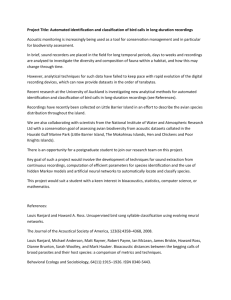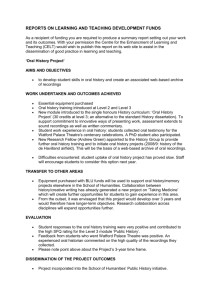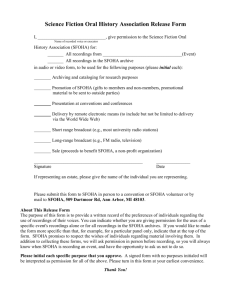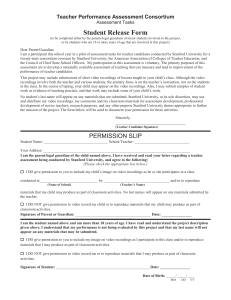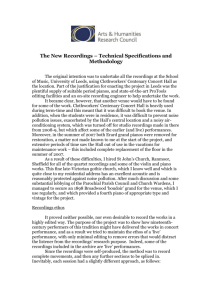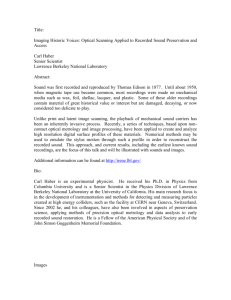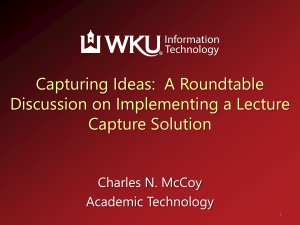Archive Introduction - University of Leeds
advertisement
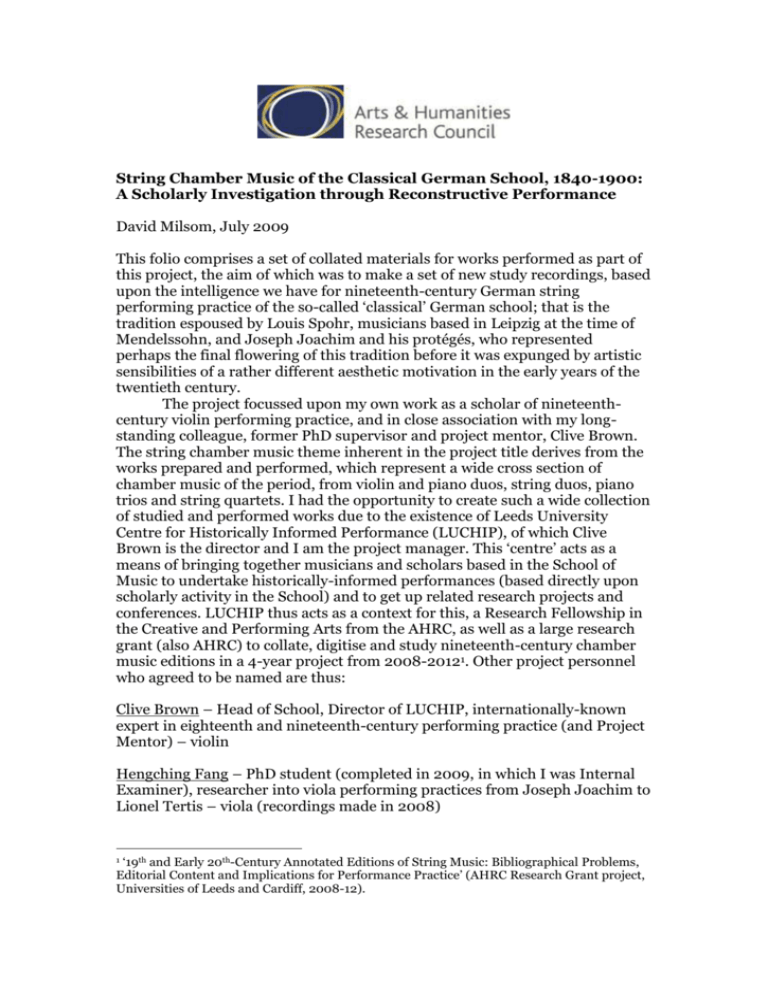
String Chamber Music of the Classical German School, 1840-1900: A Scholarly Investigation through Reconstructive Performance David Milsom, July 2009 This folio comprises a set of collated materials for works performed as part of this project, the aim of which was to make a set of new study recordings, based upon the intelligence we have for nineteenth-century German string performing practice of the so-called ‘classical’ German school; that is the tradition espoused by Louis Spohr, musicians based in Leipzig at the time of Mendelssohn, and Joseph Joachim and his protégés, who represented perhaps the final flowering of this tradition before it was expunged by artistic sensibilities of a rather different aesthetic motivation in the early years of the twentieth century. The project focussed upon my own work as a scholar of nineteenthcentury violin performing practice, and in close association with my longstanding colleague, former PhD supervisor and project mentor, Clive Brown. The string chamber music theme inherent in the project title derives from the works prepared and performed, which represent a wide cross section of chamber music of the period, from violin and piano duos, string duos, piano trios and string quartets. I had the opportunity to create such a wide collection of studied and performed works due to the existence of Leeds University Centre for Historically Informed Performance (LUCHIP), of which Clive Brown is the director and I am the project manager. This ‘centre’ acts as a means of bringing together musicians and scholars based in the School of Music to undertake historically-informed performances (based directly upon scholarly activity in the School) and to get up related research projects and conferences. LUCHIP thus acts as a context for this, a Research Fellowship in the Creative and Performing Arts from the AHRC, as well as a large research grant (also AHRC) to collate, digitise and study nineteenth-century chamber music editions in a 4-year project from 2008-20121. Other project personnel who agreed to be named are thus: Clive Brown – Head of School, Director of LUCHIP, internationally-known expert in eighteenth and nineteenth-century performing practice (and Project Mentor) – violin Hengching Fang – PhD student (completed in 2009, in which I was Internal Examiner), researcher into viola performing practices from Joseph Joachim to Lionel Tertis – viola (recordings made in 2008) ‘19th and Early 20th-Century Annotated Editions of String Music: Bibliographical Problems, Editorial Content and Implications for Performance Practice’ (AHRC Research Grant project, Universities of Leeds and Cardiff, 2008-12). 1 Jonathan Gooing – RNCM repetiteur, piano tutor at Sheffield University, Senior Lecturer at Bishop Grossteste College, Lincoln, piano (my regular duo partner since 1992, with extensive HIP experience with me from 2000 to present day) I have also been assisted by the following people: Kerry-Anne Kubisa, recording engineer, School of Music, University of Leeds Mark Wales, freelance IT consultant, who has helped me prepare the archive materials and edition scans Ruth Milsom, my wife, piano teacher and accompanist, fellow partner in Milsom School of Music (my instrumental teaching practice in Sheffield), miscellaneous administrative and research assistance including helping to set up the recording sessions at St John’s Church, Ranmoor, Sheffield. Each work file contains an MP3 sound file of my performance of this work, along with analysis of historical renditions relevant to my recording2, along with scanned images of relevant editions (replicating, as relevant, my analysis annotations of old recordings and/or my own markings used in the performances), as well as Excel graph images plotting tempo rubato, gained from analysis of historical and new recordings by the Sonic Visualiser programme. There is also a brief verbal commentary’ which aims to highlight some of the main issues inherent in the performance of each work, with references to external studies, including my own previous text, Theory and Practice in Late Nineteenth Century String Performance (Aldershot, 2003) which acts as a context and provides further scholarly substantiation of this research-based, performance project. Clive Brown’s seminal text, Classical and Romantic Performing Practice 1750-1900 (Oxford, 1999) provides the detailed scholarly background informing this project. These texts should be viewed in conjunction with this project archive. The purpose of the archive is to demonstrate, in practice, the fruits of academic research into string performance practices of this period, focussing specifically upon violin playing. All performances were made after careful consideration of annotated editions and early recordings, where available, and against the backdrop of scholarly knowledge I have gained in the past fourteen years (since beginning my MMus research, which also considered the intelligence of early recordings and in the case of this preliminary study, their relevance to eighteenth-century music3). The recordings are far from perfect technically – and this is not primarily their intention in any case. What I seek to demonstrate is that, with careful consideration of the documentation and a free and unprejudiced view of performance style in many ways diametrically opposed to modern practices, it is possible to get up performances that display at least something of the performing practices of this tradition. This work is unique to my knowledge in both its scope and its intentions – modern HIP in Mechanical copyright restrictions have precluded inclusion of sound files of any such historical (and commercially-re-released) recording. See Discography for relevant details. 3 D. Milsom, Early Recordings and Musical Style 1900-1950: Approaches to Baroque and Classical Violin Repertoire (unpublished M.Mus thesis; Sheffield, 1996). 2 the commercial domain being merely modern performances influenced incompletely by the known evidence, and much performing practice musicology being primarily academic research. To further explain the project and provide context I have appended several chapters, as follows: 1. Rationale and Purpose of the Project – The Problem of LateNineteenth-Century String Performance Practice 2. Physical and Practical Factors – Issues of Organology 3. The New Recordings – Technical Specifications, Methodology 4. Specific performance intelligence 1 – the issue of annotated performing editions 5. Specific performance intelligence 2 – early recordings 6. An unpublished article written by me in 2008 on Marie Soldat-Roeger 7. An unpublished article written by me in 2007 on Joseph Joachim 8. Outputs and Dissemination: Talks, Articles and Activity undertaken during the project 9. Bibliography 10. Discography 11. List of scores used in the project How to use this archive The aim of this archive is to enable the enquirer to listen to the project recordings, read a brief ‘liner note’ – style explanation of the interpretative decisions taken, and to view any relevant analyses and/or scores used in the project. Accordingly, each work has a separate file containing all documents relevant to it. This has resulted in some duplication because the archive might not be viewed in chronological order. Annotated scores etc give information about essential analysis material. For a thorough understanding of the scholarly underpinnings of the project, the archive should be viewed in conjunction with my previous text, Theory and Practice in Late Nineteenth-Century Violin Performance 1850-1900 (Aldershot, 2003) and Clive Brown’s Classical and Romantic Performing Practice 1750-1900 (Oxford, 1999). The recordings/tracks in each work file (ie. ‘Disc 2 Track 1’) are labelled according to the disc contents as laid out in the Recordings List file.
